Engaging preventive care adopters
Data-driven user profiling
What do potential users look for in preventive healthcare services? How does their state of health affect their approach to these services? These questions contribute towards building up user profiles of a potential target audience for preventive healthcare. Understanding these profiles can then help us to design for and engage users more effectively, according to their health goals and requirements.
To establish a set of user profiles, we conducted a 4-week qualitative survey with 138 respondents. This survey was split into sections regarding: the respondent’s demographics, how they perceive their health status, their attitude towards health in general, habits and preferences, any health screening experiences and finally, their opinions on the future of healthcare. The results enabled us to gain insight into respondents’ perceptions of preventive health, identify major commonalities across different demographics, and formulate engagement strategies.
Based on this data, we were able to identify five prevailing user profiles, and pinpoint the factors motivating them towards or dissuading them from healthier habits. These profiles are: the Unwell, the Fatigued, the Too Busy for Health, the Active Lifestyle Seeker, and the Peak Performer.
To establish a set of user profiles, we conducted a 4-week qualitative survey with 138 respondents. This survey was split into sections regarding: the respondent’s demographics, how they perceive their health status, their attitude towards health in general, habits and preferences, any health screening experiences and finally, their opinions on the future of healthcare. The results enabled us to gain insight into respondents’ perceptions of preventive health, identify major commonalities across different demographics, and formulate engagement strategies.
Based on this data, we were able to identify five prevailing user profiles, and pinpoint the factors motivating them towards or dissuading them from healthier habits. These profiles are: the Unwell, the Fatigued, the Too Busy for Health, the Active Lifestyle Seeker, and the Peak Performer.
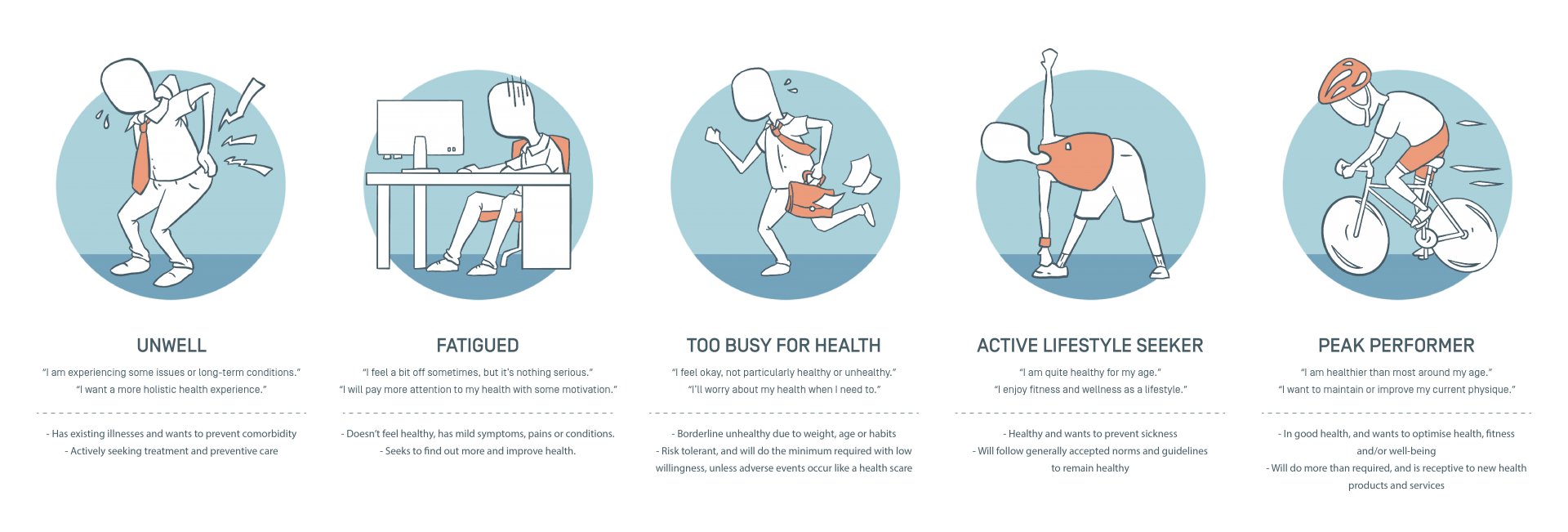
UNWELL
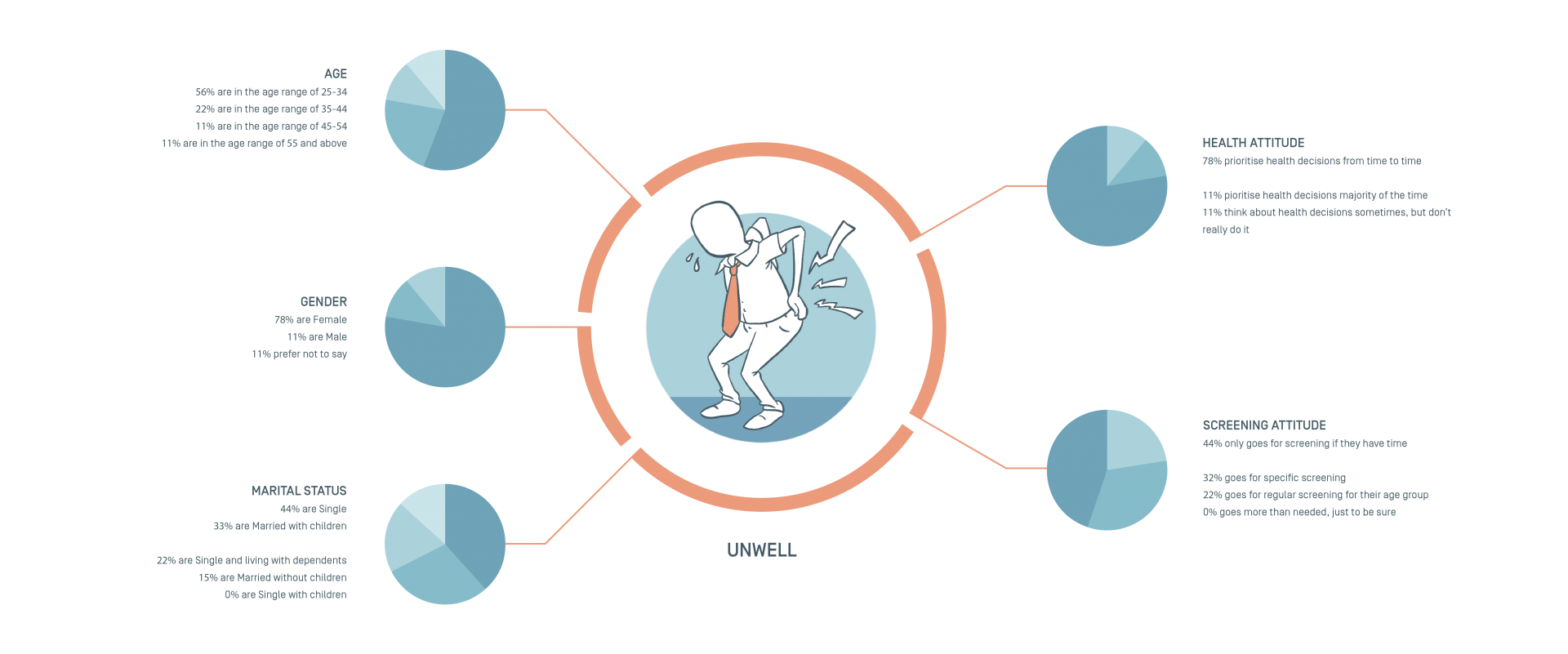
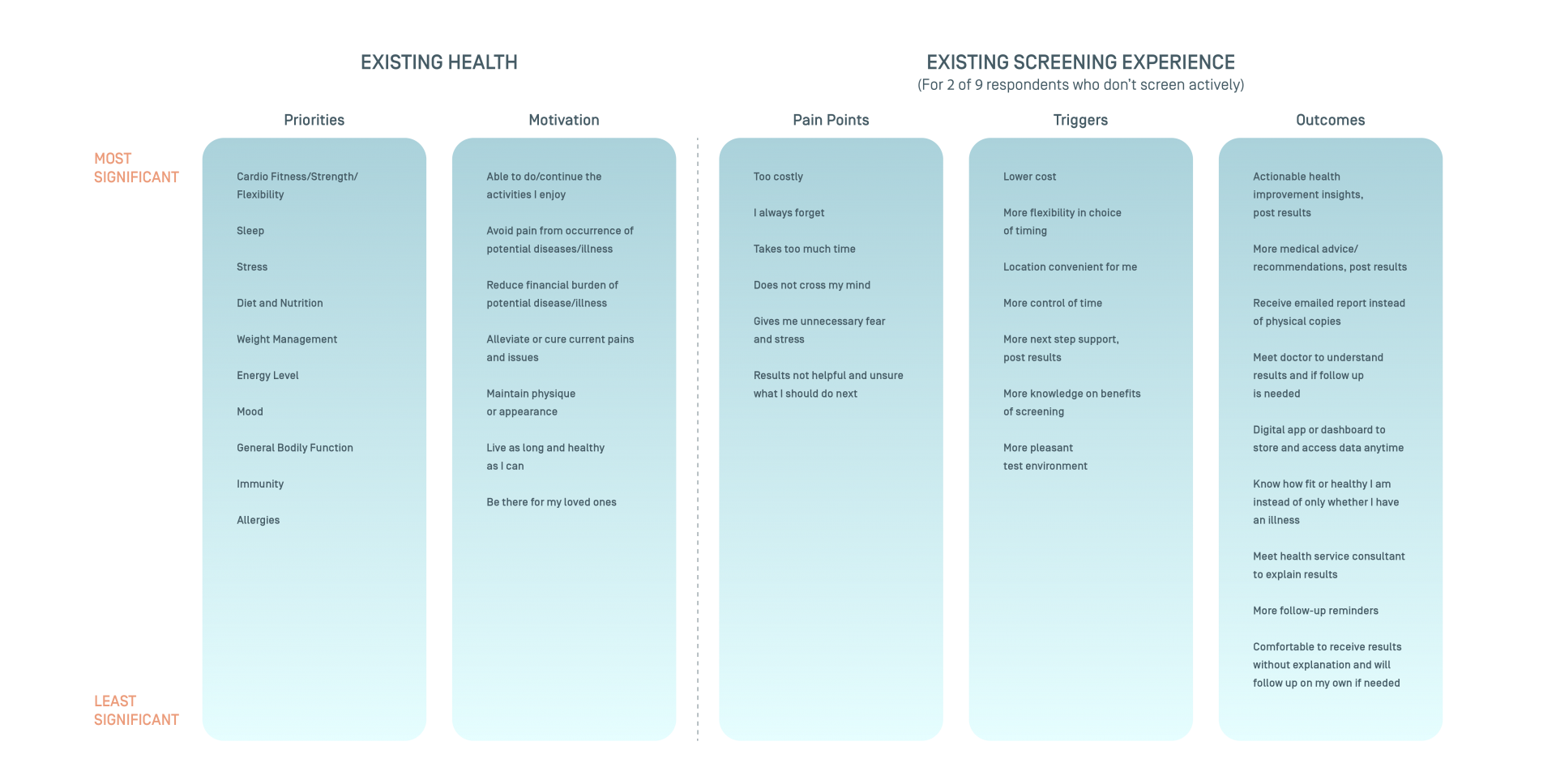
Most respondents who see themselves as ‘Unwell’ are female, in their late twenties to mid-thirties. The majority are single, with the second largest subset being married parents. A large percentage prioritise their health only from time to time, and almost half the respondents only go for screenings if they have time. About a third report that they will go for specific screenings. They tend to prioritise more immediate aspects of health, such as fitness, stress, sleep, nutrition and weight, and their main motivation for regulating health comes from wanting to continue their lifestyle, managing current ailments, and avoiding implications from future illness such as pain or financial cost.
FATIGUED
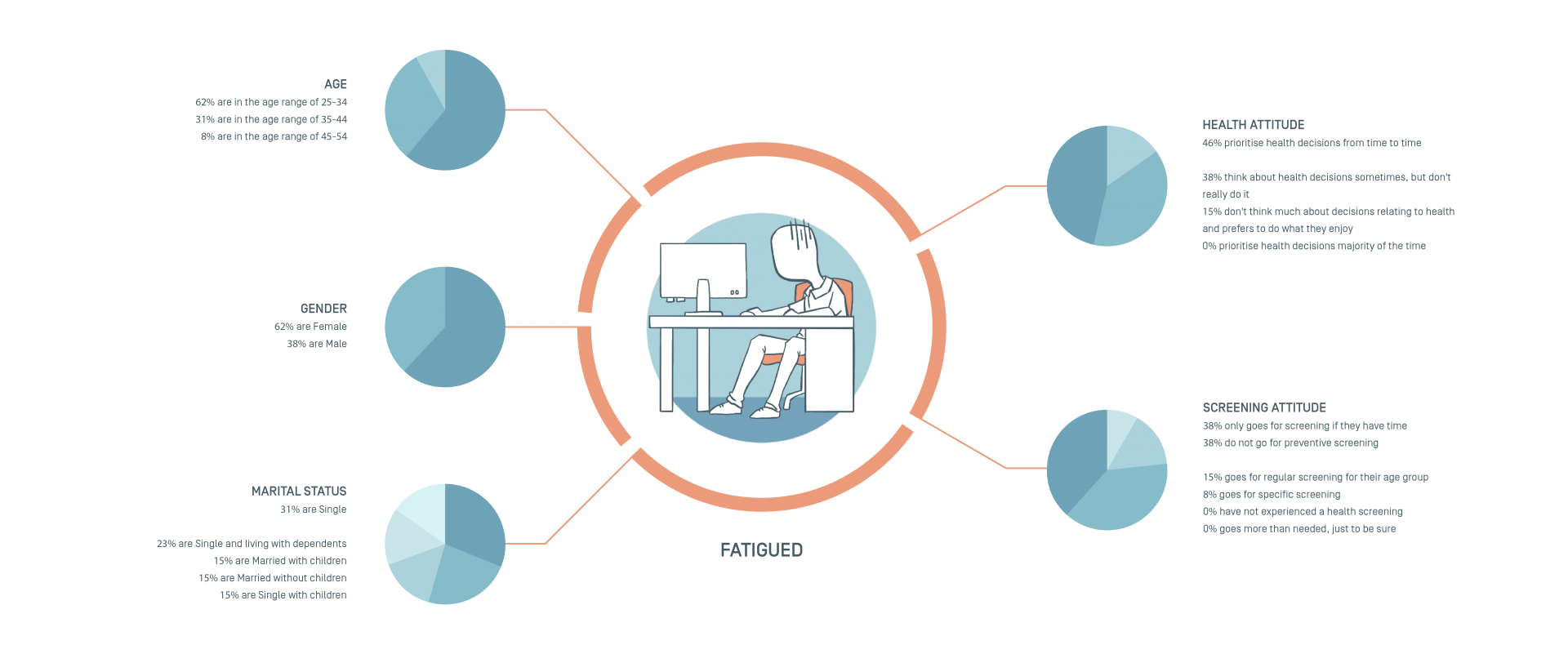
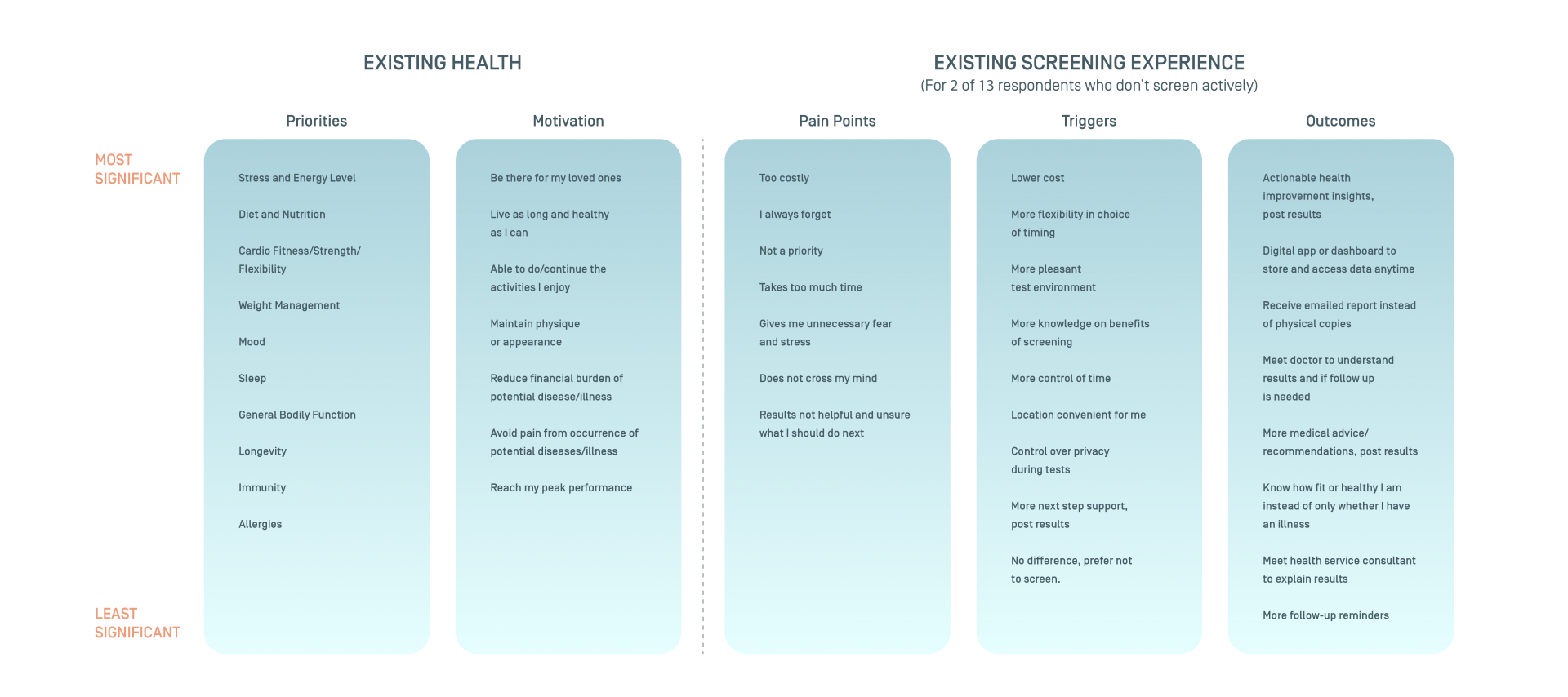
The ‘Fatigued’ group are also largely female and mostly between the ages of 25 to 34. Most respondents are single, with some either living with dependents or children. None of the respondents prioritise their health, and of all those surveyed, this group contains the highest percentage who prefer to do what they enjoy without thinking about health. Many also consider their health, but are unmotivated to act on it. This is reflected in the group’s attitude towards health screening, as there are equal numbers of respondents who only go for screenings if they have time, or do not go for screenings at all. Many state that challenges to regular screening include cost and simply forgetting to go. Their priorities are focused on factors that impact their daily lives, such as stress, mood and energy, but also on nutrition, weight and fitness. Many are motivated by the ability to continue their activities, maintaining their form and being with their loved ones for as long as they can, and considerations of the burdens of future illness.
TOO BUSY FOR HEALTH
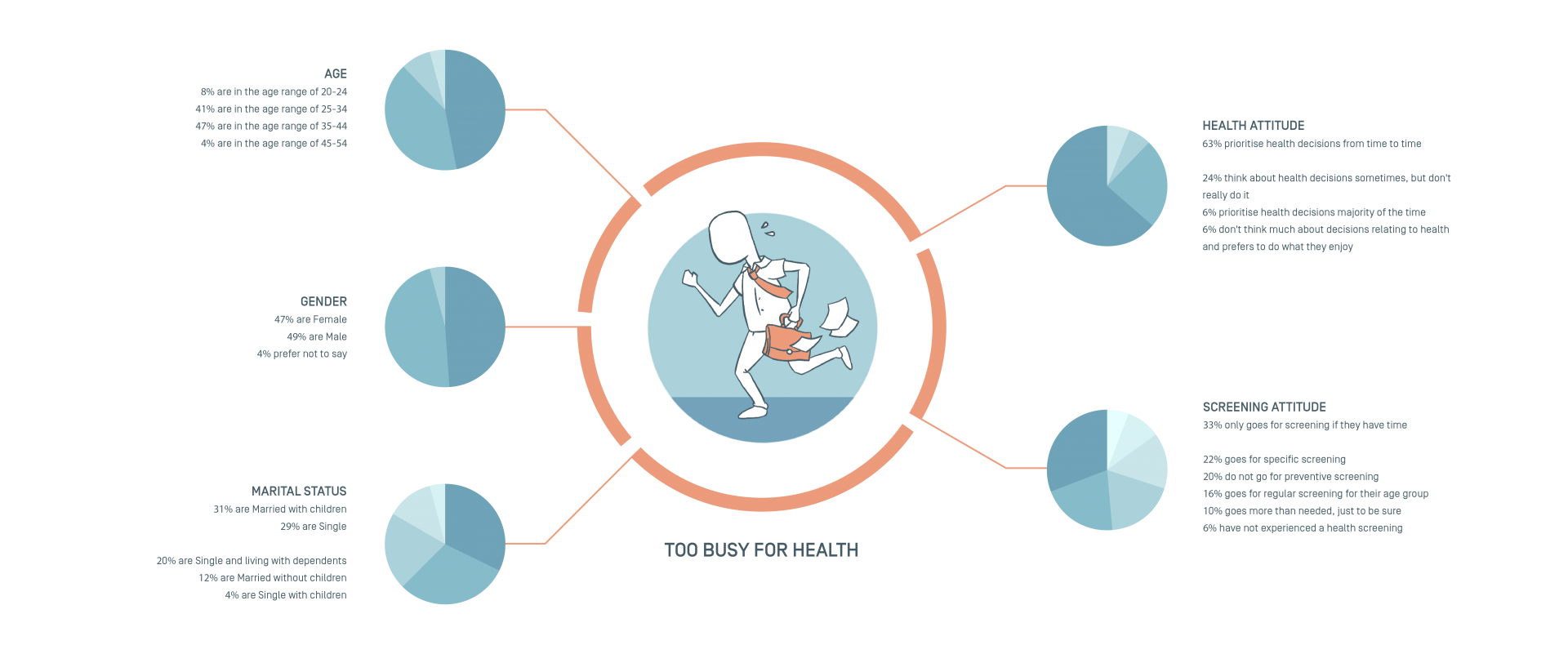
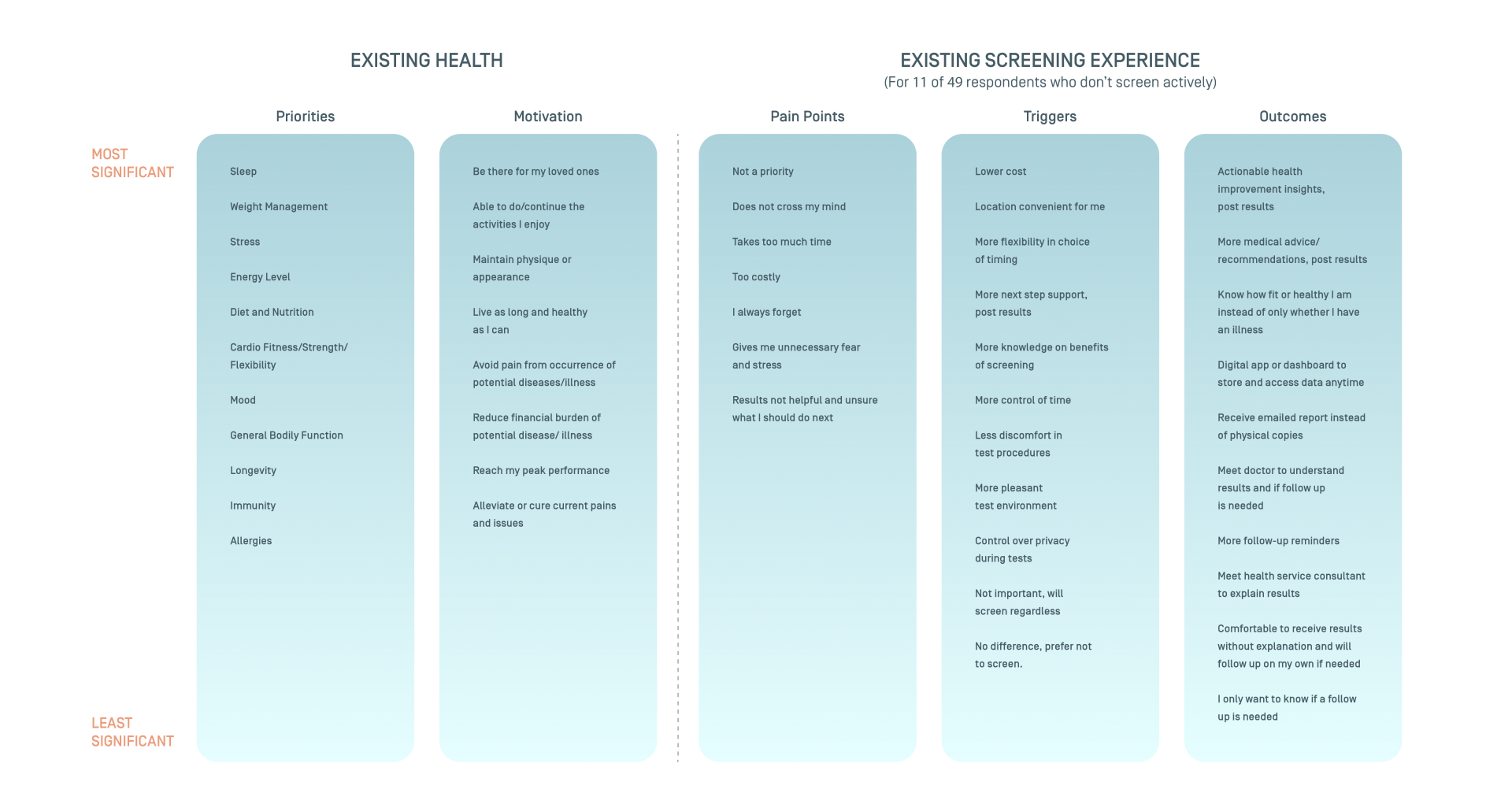
Of those who see themselves as ‘Too Busy for Health’, there is almost an even split between male and female, with slightly more respondents falling within the 35 to 44 age range than 25 to 34. Most are single, some living with dependents or children, but almost a third are married with children. The majority prioritise their health occasionally, and also go for screenings, although a third report that they do so only if they have time. Of this group, a quarter indicate that they either do not go for, or have not experienced a health screening. Health screenings are not a priority, or take up too much time. Their largest priorities are sleep, stress and weight, and fitness or nutrition are not important concerns. Many are motivated by being able to prolong their time with loved ones or doing things they enjoy.
ACTIVE LIFESTYLE SEEKER
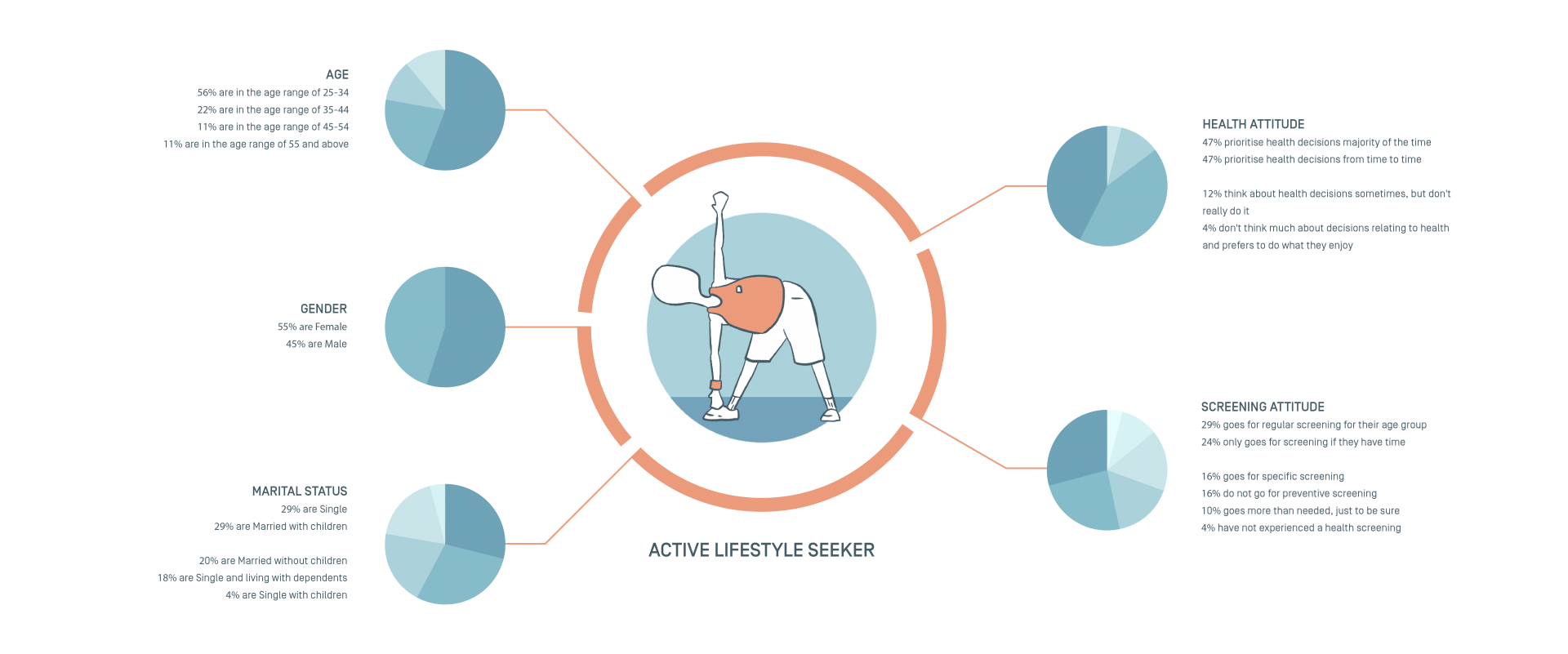
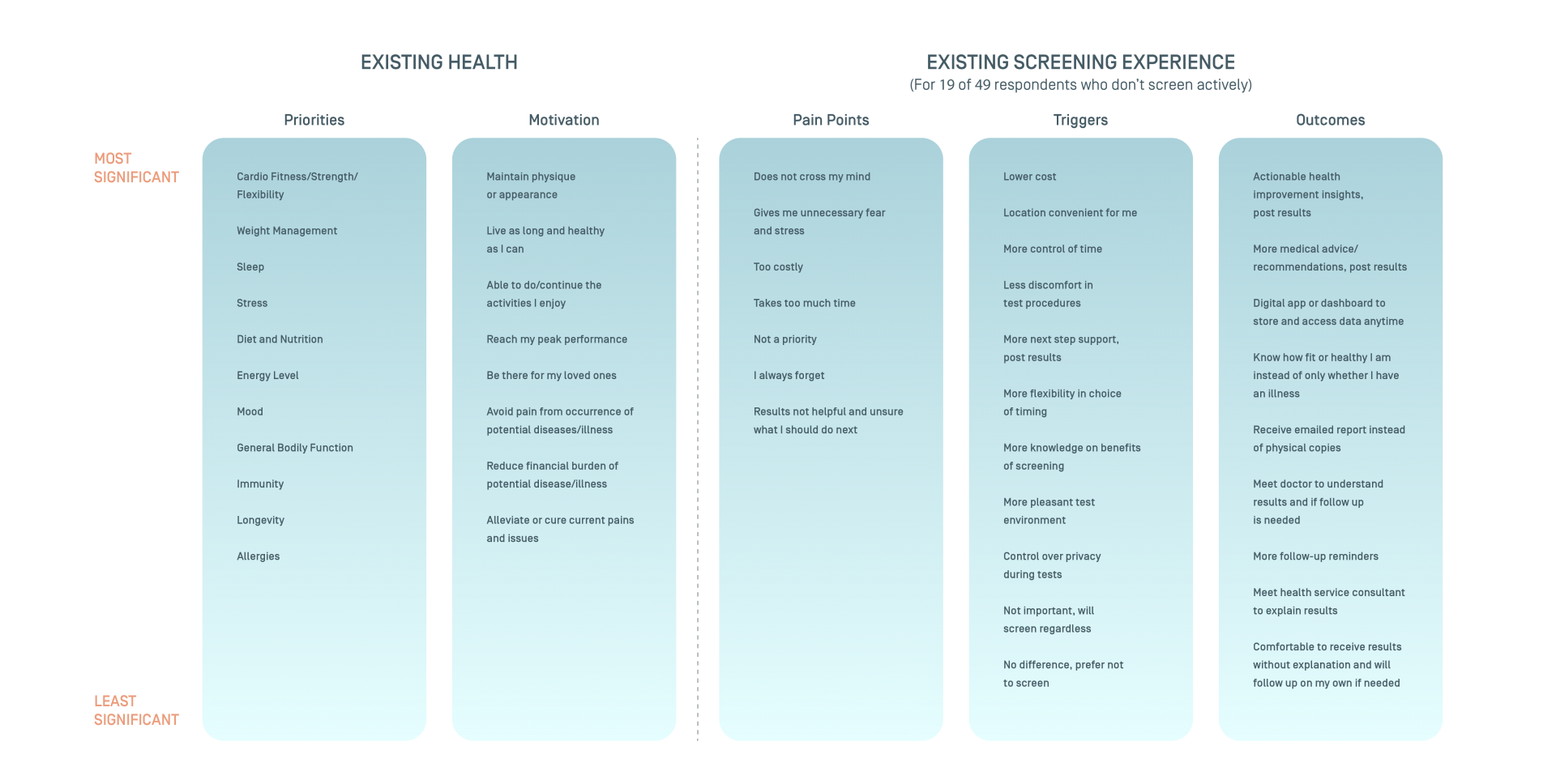
Most ‘Active Lifestyle Seeker’s are young, with just over half being in their late twenties to mid-thirties. More identify as female than male, with a fairly even split between those who are single and married, as well as those with dependents or children, and without. An overwhelming majority will prioritise their health, although there is an even split between those who do so most of the time, and those who only do so sometimes. The majority also go for health screenings, with less than a third of the group going regularly. Most report that they either do not think about health screenings, or wish to avoid the fear and stress that come with the results. This group prioritises fitness, weight, sleep and stress management, and are motivated to continue their lifestyles, upkeep their appearances, and hit peak performance.
PEAK PERFORMER
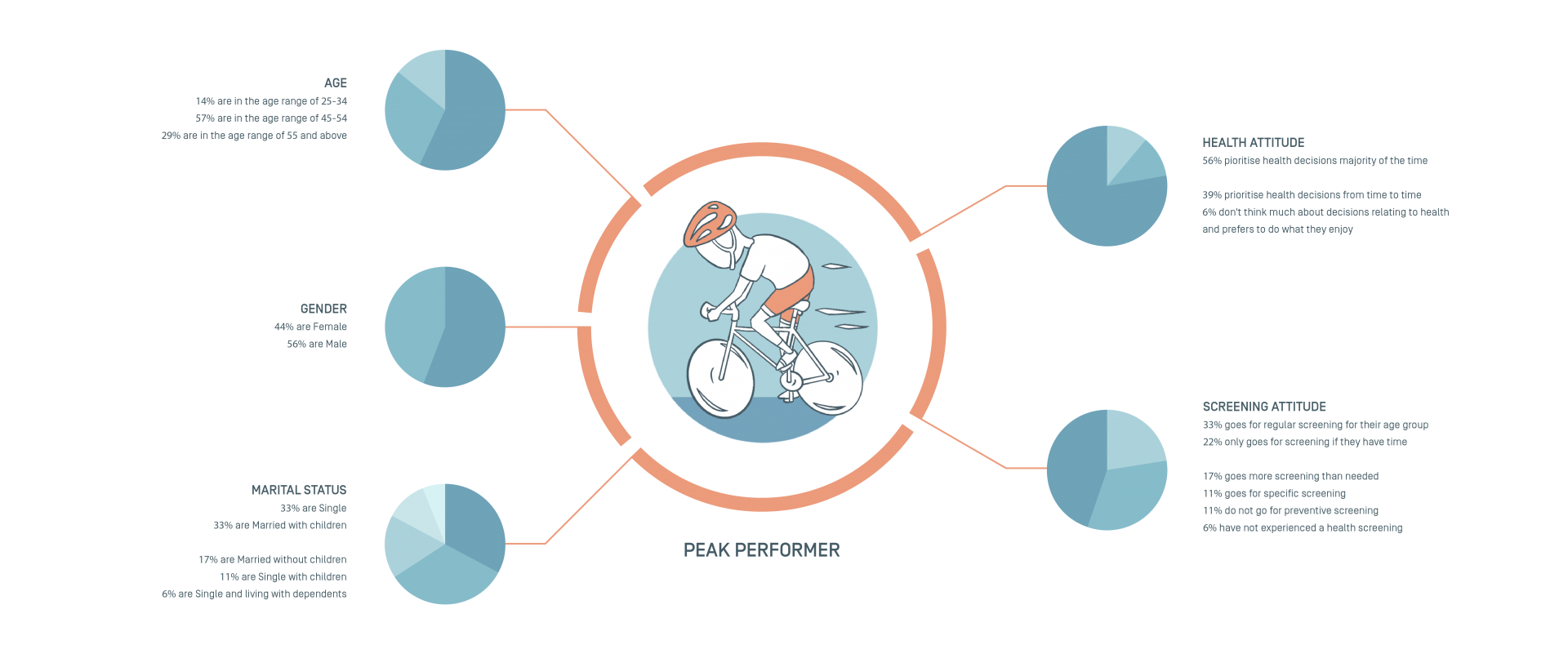
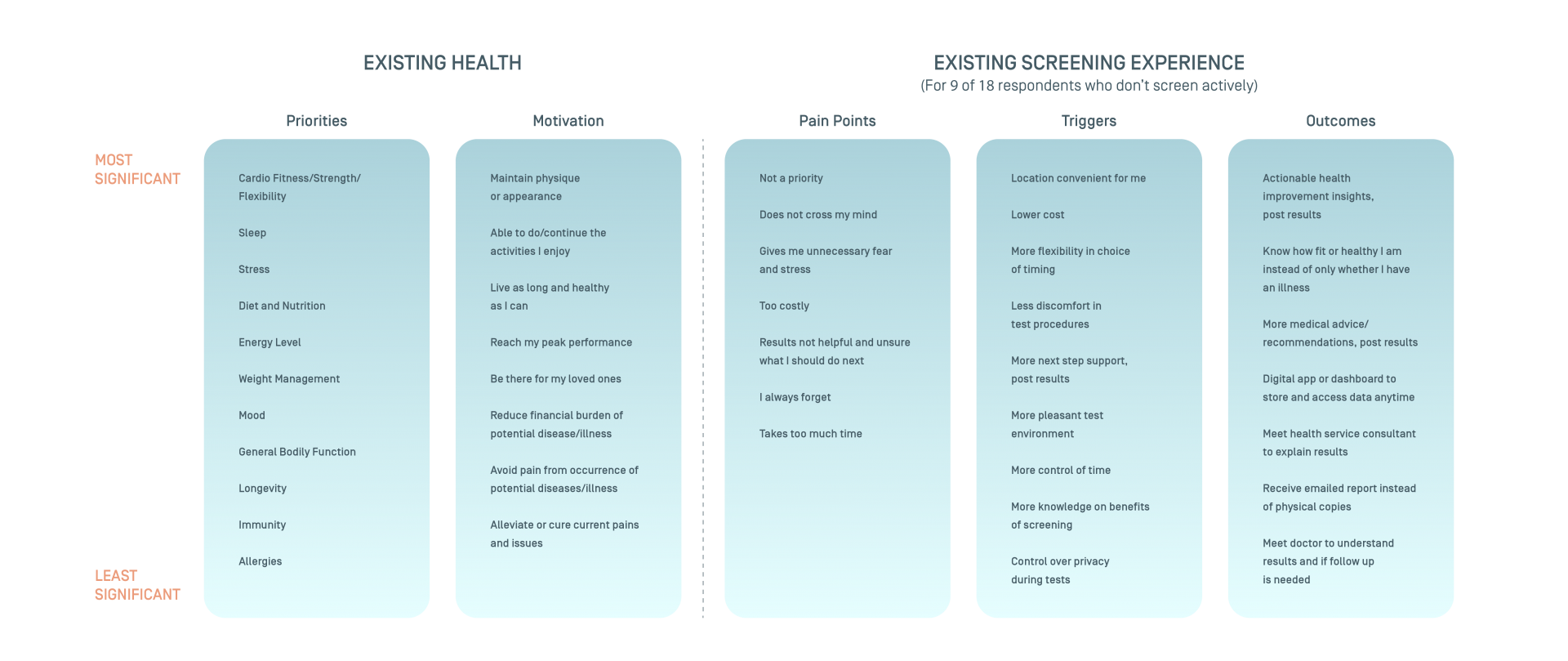
‘Peak Performer’s are largely male, between the ages of 45 to 54. Half are married, and half of the group regardless of marital status have children or dependents. A majority will prioritise their health, with over half doing so most of the time. Similarly, most go for health screenings, with a third reporting that they do so regularly for their age group. Otherwise, they do not prioritise health screenings, or do not want the unnecessary stress from negative results. They are focused on fitness, sleep, stress and nutrition, and are motivated to maintain and prolong their current conditions.
USER ENGAGEMENT
While all five user groups report varying concerns, motivations and levels of proactivity, they all agreed that more flexibility and convenience with regards to screening locations and timing, as well as lowered cost, would be significant factors in their adoption of regular health screenings. The translation of data into insights and actionable tasks for them to adopt were also of interest to all groups.
All user groups harbour similar desires to live longer and healthier, differing mostly in their definitions of the quality of life they would like to prolong, such as physical appearance versus time with loved ones. The approaches and priorities towards these goals vary as well, depending on their pre-existing conditions or time set aside for health. This has an effect on the methods we adopt in engaging each user group, with special considerations of their pain points and triggers, as illustrated below:
All user groups harbour similar desires to live longer and healthier, differing mostly in their definitions of the quality of life they would like to prolong, such as physical appearance versus time with loved ones. The approaches and priorities towards these goals vary as well, depending on their pre-existing conditions or time set aside for health. This has an effect on the methods we adopt in engaging each user group, with special considerations of their pain points and triggers, as illustrated below:
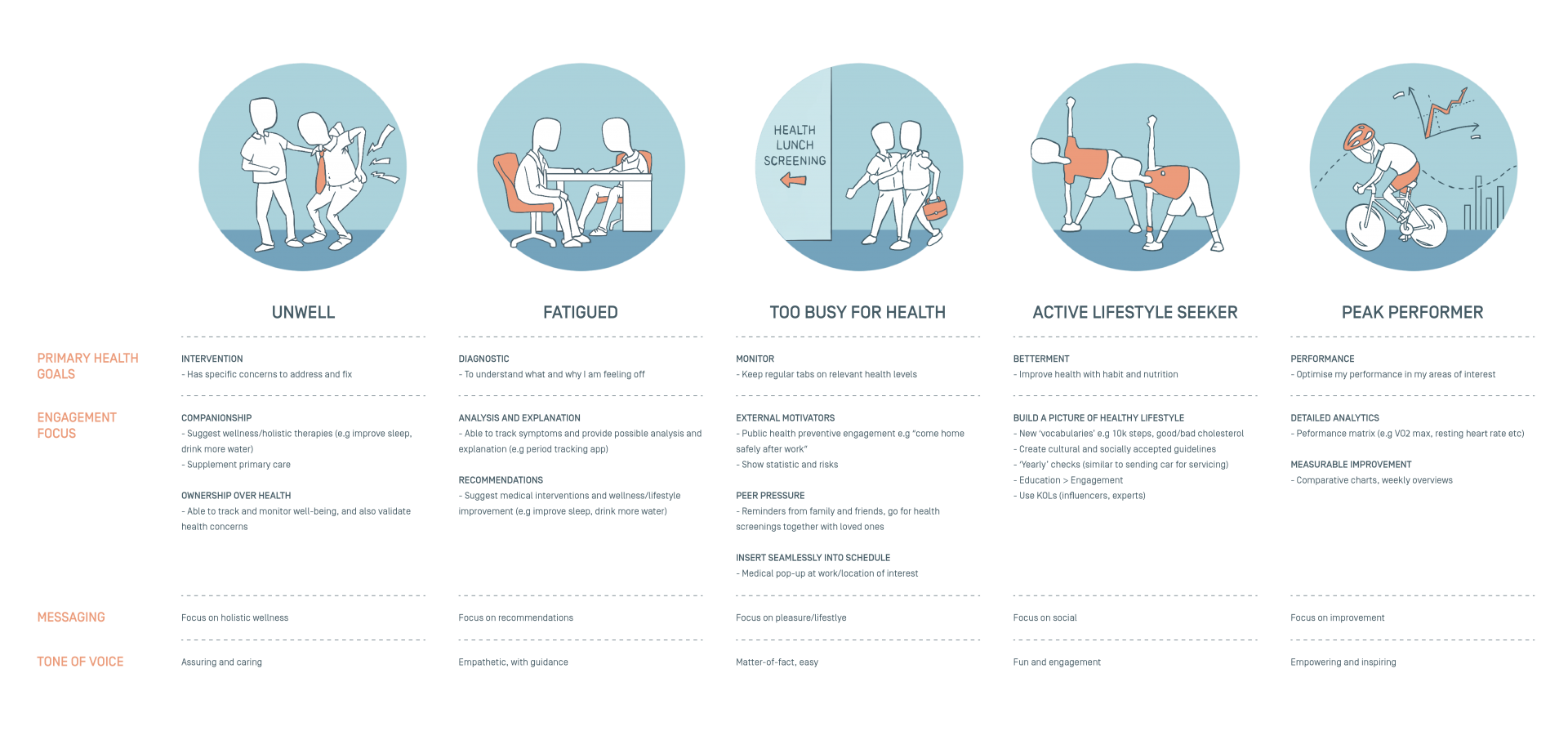
From this study, we gained insights into the levels of proactivity different user groups have towards their health, what aspirations they have, and how we may not only engage them in the design of preventive care services, but bridge the gap between product and user to ensure a frictionless experience.
The use of data in profiling the survey respondents allowed us to extrapolate and observe broader trends, while also minimising any bias we might have in forming initial impressions of potential users. With these profiles, further in-depth interviews, workshops, and testing can be carried out to further refine the product offering.
The use of data in profiling the survey respondents allowed us to extrapolate and observe broader trends, while also minimising any bias we might have in forming initial impressions of potential users. With these profiles, further in-depth interviews, workshops, and testing can be carried out to further refine the product offering.
BEST WHEN TAKEN WITH A PINCH OF SALT.
PLEASE EMAIL FARMACY@FARM.SG WITH YOUR FEEDBACK, OR IN CASE OF ANY INACCURACIES.
PLEASE EMAIL FARMACY@FARM.SG WITH YOUR FEEDBACK, OR IN CASE OF ANY INACCURACIES.
REF. NO.
INSIGHTS-013-PREVENTIVE-CARE-USER-PROFILE
CONTRIBUTOR(S)
LIJIN TAN, JAXE PAN, BENEDICT TAY, TAN QIAN ROU
PUBLISHED
30.06.22